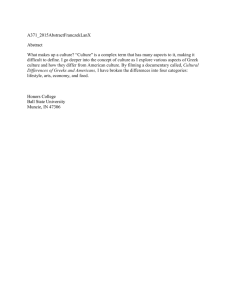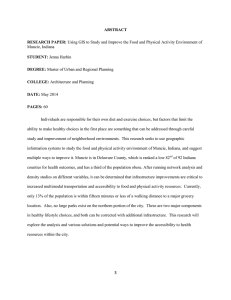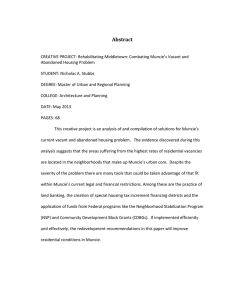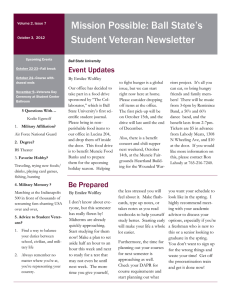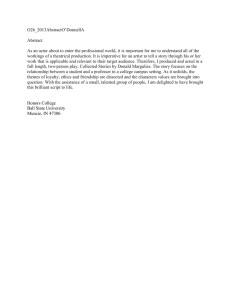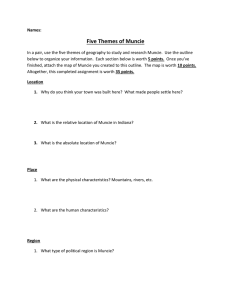499)
advertisement
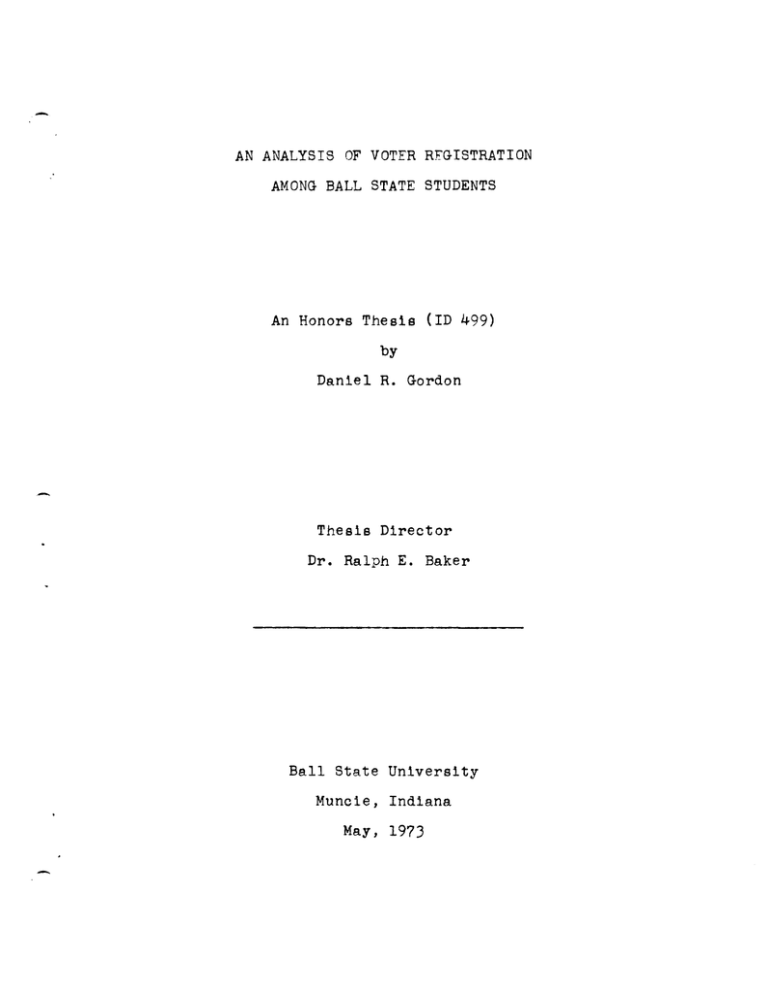
AN ANALYSIS OF VOTER REGISTRATION
AMONG BALL STATE STUDENTS
An Honors Thesis (ID 499)
by
Daniel R. Gordon
Thesis Director
Dr. Ralph E. Baker
Ball State University
Muncie, Indiana
May, 1973
Sf, Co Ii
-r Ilr? :: I :')
.&~,7
I would like to take this opportunity to thank all of
those ppople who helped make this project possible.
Miss
Mic~he
Specifically:
lle Bullard, who helped with the telephone interviews,
Dr. Donald Mikesell, who helped obtain the random sample used
herein,
Dr. A. K. Corbett, who set up the coding scheme and the program
for the computer analysis of the data,
Dr. Ralph E. Baker, who I was fortunate to have as my advisor
and who gave me many valuable suggestions throughout
the course of my research,
Mr. Mike Huffma.n, who tolerated my marathon telephoning sessions
during the interview stage of my research,
and all of my friends who gave me encouragement and advice.
i
AN ANALYSIS OF VOTER REGISTRATION
AMONG BALL STATE STUDENTS
During the period between November of 1970 and November of 1972, millions of young people were enfranchised.
Some had celebrated their twenty-first birthday, while others
benefitted from the passage of the Twenty-sixth Amendment.
The distinction mattered little to politicians, who saw only
votes-for or against.
These men expressed joy or dismay
depending mostly upon their ideology.
Many liberals were
overjoyed at the prospect of millions of new votes for their
cause while numerous conservatives expressed dismay at the
possibility of the young voters.
Pollsters had shown that a
majority of' the new voters favored the liberal position on
many issues.
However, neither liberals nor conservatlves
had developed a faolproof means of translating these liberal
viewpoints into votes at election time.
No one was positive
whether young voters would vote with thelr convictions or
along the same lines as their parents or by some other formula.
This uncertainty was troubling to many, especially
politicians in college towns.
They had no way of determining
whether the concentration of potential voters in their cities
would fit nicely into the political system or whether they
1
2
would continue the proverbial feud between town and gown.
In many states laws were passed which prohibited students
from voting in the city where they attended school.
was no exception.
Indiana
Under the Indiana law Persons were not
allowed to register to vote in cities where they resided
primarily for educational purposes.
This law had Borne strange ramifications.
In Delaware
County students residing in dormitories were not allowed to
register while many married students living in off-campus
housing were permitted to register.
a lawsuit in the fall of 1971.
This situation led to
The outcome of the suit was
that students could register and vote in Delaware County.
The local politicians received this verdict with the same
mixed emotions as were in evidence at the national level.
They began to make their preparations to meet the onslaught
of the student vote.
Because of my close relationships with important people
of both parties, I
~came
aware of these preparations.
I
gained knowledge of the Democratic Party's measures through
discussions with my roommate, Mike Huffman, who was the Democratic candidate for State Representative from the district
which included the campus.
My access to Republican plans
was much greater because I was a member of many planning
sessions.
Bpcause of my positions as President of the Ball
State Young Republicans and Chairman of the Students for
-
DenniS, I had to help formulate many of the Republican plans
3
for the youth vote.
As the autumn wore on and I heard more and more theories
on the possibilities and probabilities of the youth vote, I
began to develop some tteories of my own.
I heard varying
estimates of the number of students registered and expected
to votE'.
Many of these were in the vicinity of five to eight
thousand.
I had reason to doubt the credibility of these
estimates.
During the summers of 1971 and 1972, I had helped
conduct voter registration drives among the young people in
my hometown.
After helping in these efforts, it was my feel-
ing that if similar efforts had been made in other cities
throughout the state then it was possible that many stUdents
would be registered in their hometown.
If many students
were registered at home, then the number of students registered
at Ball State would be fewer.
The number of students regi-
stered at Ball State would consist of those who had registered
in Muncie during the previous school year plus those who had
registered in Muncie during the fall of 1972.
There had been approximately three thousand students
registered during the previous year and almost two thousand
more had registered in the fall of 1972.
politicians
esti~ated
five thousand.
Therefore, many
the student vote possibility at about
I disagreed because through working with the
registration records, I had discovered that well over fifty
percent of those registered during the previous year no longer
4
held valid registrations.
Many had left school while others
had moved to a new precinct without bothering to transfer
their registration.
Eventually election day dawned and much of the speculation about the student vote was forgotten as the student
vote was swallowed up in the Republican landslide.
After the
election no one bothered to count how many students actually
had voted in Muncie.
The student vote would be forgotten
until another election drew near.
HowevFr, I was still curious
about some aspects of the student vote.
to the writing of
t~is
My basic goal
This curiosity led
paper.
W9.S
to determine approximately what per-
cent of the students were registered to vote in Muncie in
comparison with the percent who were registered in their
hometown.
After finding tris ratio, I hoped to express some
reasonable hypotheses that would explain this result.
The first problem I encountered was in obtaining the
necessary data.
,.
the lack of time.
I decided to use a telephone poll because of
I did not have sufficient time to conduct
personal interviews and I felt that telephone interviews
\ ~
\
,
would not be of significantly less value.
I constructed the
\.,
\
questionnaire (Appendix A) with this in mind.
There were no
open ended questions because I did not feel that there would
be sufficient time for a proper analysis of the results.
For my testing I wanted to use a random sample from
all Ball State University students attending the Muncie campus.
5
Dr. Donald Mikesell, Dirr-ctor of Student Affairs Research,
gave me his full cooperation and helped me to obtain such a
sample from the computer files of the University.
The sample
consisted of four hundred and eight names in the following
proport ion s:
MEN
WOMEN
52.45.~
FRESHMEN
SOPHOHORES
JUNIORS
SENIORS
47.55%
28. 92~'"
24.26%
21. 57%
25.25%.
This sample constituted three percent of the undergraduate student body.
From this sample I obtained the subjects
for the telephone interviews.
Since I did not have time to
contAct 8.11 four hundred and eight students,
.-
through the list from the
b~ginning
I simply went
calling each person.
A large percentage of the calls were not completed because the
potential interviewee was not home.
At the end of three weeks,
I had spent between thirty and forty hours on the telephone
and had. succeeded in conducting one hundred two interviews.
I would. have liked
~o
interview all of the persons in the
sample, but there was just not enough time.
With a sample of one hundred and two interviews out of
a possible four hundred and eight interViewees, I thought
the proportions might have been altered materially.
However,
upon analysis, the proportions for the categories of SEX and
GRADE were determined to be as follows:
MEN
'WOMEN
52.0%
48.0%
FRESHMEN
SOPHOMORES
JUNIORS
SENIORS
30.4%
24.5%
22.5%
22.5%
6
Even though there were differences
bet~een
these proportions
in the original sample and in the final sample, I did not feel
that the variance was great enough to invalidate the study.
After I had finished the interviewing stage, I began
the task of analyzing
meth~d
t~e
data.
I determined that the best
of analysis would be the use of a computer.
Because
I was not familiar with the techniques involved in the computer
analysis of this type of data, I enlisted the aid of Dr. A. M.
Corbett in the Political Science Department.
He helped me to
determine a coding scheme for the questionnaire (Appendix B)
and he also set up the program to be used by the computer in
the analysis of the data.
At this point I keypunched the
data and the program onto "computer cards" and submitted the
package to the computer.
The output which I received is the
basis for the conolusions listed in the rest of this paper.
This output consisted of charts showing the distribution
J'--"'-
of answers to each of the qupstions and also of crosstabs.
f
~
,\
The crosstabs indicated the amount of relationship which
existed between two specified variables with the existing
q~grees
~.'
of freedom.
By then comparing this value of chi
square with values listed in a calculated chi square table,
it was possible to determine if this relationship was significant at the .05 level of probability_
I decided to use the
.05 level because of the low number of cases involved and also
because of the nature of the study, which was not perfect.
/
7
The original purpose of this research was to determine
whether most students were registered to vote in their hometown or in Muncie.
My theory had been that most students
would be registered in their hometowns.
However, when it
became evident that this question could be answered rather
eaDlly, the research was expanded to cover otter areas.
The
research eventually led to an investigation of why students
registered in one place or the other.
The original theory
will be discussed first and then the subsequent hypotheses
will be analyzed in the order in which they appear on the
computer printouts, labeled- OUTPUT A and OUTPUT B.
The status of the original theory is evident if one
looks s.t page 30 of OUTPUT A.
There it is shown that a maj ori ty
of students maintained their registratlon in their hometown.
This is the result when stUdents who consider Muncie as their
hometown are included.
If they were to be excluded, then the
margin in favor of hometown registretion would be nearly two
to one.
This data is important but it has few implications
for the futUre by itself.
It is neceDsary to look at some of
the possible causes of this effect before conclusions can be
drawn about its relevance for the future.
In order to look at some of these possible causes, it
is necessary to consider the other variables that were involved
in the study. Since the main concern is to observe the relationship that exists between these variables and where the
8
student was registered, it is not necessary to examine closely
the distribution charts for the individual variables.
However,
it is l.mperative that the crosstabs charts be analyzed and the
values of chi square be noted.
It seems that the simplest
method of accomplishing this is to start with the first crosstabs chart on page 42 of OUTPUT A and then proceed through
th~
rest of the crosstabs charts in OUTPUT A and also those
in OUTPUT B.
By doing them in order it will make it easier
for a reader to follow the explanation written in the text.
(., VOTPLACE X PARTY
In this correlation it can be seen that that the value
of chi square does not indicate a high degree of correlation.
However, there does seem to be a tendency for Republica.ns to
register at home.
.. \ \ \
VOTPLACE X AGE
,.. A
'
! 1
.1
J~,
1/"
I"
There does seem to be a valid correlation in this
relationship.
Apparently, students have a tendency to register
, '
in Muncie as they become older.
\
\
VOTPLACE X HOMREG
It is evident that there is a significant relationship
between these two variables.
Those people who were registered
at home before they came to Ball State had a distinct tendency to maintain their registration in their hometown.
9
VOTPLACE X SEX
There seemed to be no correlation between a person's
sex and their place of registration.
VOTPLACE X GRADE
There existed a distinct relationship between one's
year in school and their voting place.
of
fres~~en
A large percentage
were registered in their hometown while a major-
ity of seniors were registered in Muncie.
VOTPLACE X LOAN SUPPORT
No evidence of a significant correlation could be
found to exist between these variables.
VOTPLACE X SCHOLARSHIP SUPPORT
There was no significant relationship between these
variables.
VOTPLACE X WORK SUPPORT
The significant relationship in this instance seemed
to indicate that those who did not depend on work as a major
source of support were more likely to be registered in their
hometown.
VOTPLACE X PARENT'S SUPPORT
This crosstab indicated that those registered in Muncie
were
l~ss
likely to depend on their parents for some part of
their support than were those registered at home.
10
VOTPLACE X SAVINGS SUPPORT
There seemed to be no significant relationship
between these variables.
VOTPLACE X G.I. BILL SUPPORT
The significant relationship in this case indicated
that those with this type of support had a tendency to
register in Muncie while those who did not depend on this
type of support for a major portion of their income had
a tendency to register at home.
VOTPLACE X PARENTIS INCOME
The chi square value in this case was not great enough
to indicate significance at the .05 level.
However, there
did seem to be a trend for those in the top two income brackets to be registered in tteir hometown.
VOTPLACE X RELATIONSHIP WITH PARENTS
T~p
chi square value in this instance indicated no
definite correlation.
VOTPLACE X ACTIVITY IN POLITICAL CAMPAIGN
There was no indication of any relationship between
these variables.
VOTPLACE X ABILITY TO NAME MAYOR OF MUNCIE
In this case it seemed as likely that someone not
registered in Muncie could name the mayor correctly as often
as someone who was registered in Muncie.
11
VOTPLACE X MARITAL STATUS
There was definitely a significant relationship
between these two variables that indicated that those who
were married had a definite tendency to register in Muncie.
VOTPLACE X PLACE OF RESIDENCE WHILE IN SCHOOL
In this case the value of chi square pointed to a
definite correlation.
There was a dpfinite showing that
those who lived in a dormitory were likely to be registered
at home,while
conversel~
those who were registered at home
had a tendency to live in a dormitory.
\
\
~,
_.
I.
l
VOTPLACE X SIZE OF HOMETOWN
It was indicated that there was some degree of correlation
between these variables.
The correlation was not overwhelm-
ing but it was within the significant level.
VOTPLACE X DISTANCE OF HOMETOWN FROM MUNCIE
Even though many students who lived within twenty-five
miles of Muncie would automatically register in MUncie because
. they lived in Delaware, there was also a distinct and significant tendency for those who lived furthest from Muncie to
register in Muncie.
This would perhaps indicate that their
ties with home were stretched almost to the limit.
VOTPLACE X STUDENT'S IDEOLOGY CLASSIFICATION
There was no indication of a significant relationship here .
-
.
12
VOTPLACE X PARr-NT'S PARTY AFFILIATION
Neither of the parent. seemed to have a large affect
on where the student would register.
It was interesting to
note, however, that only when the parents were moderate
Democrats did a majority of students register in Muncie.
VOTPLACE X PARENTS OVERPROTECTIVE
The significant correlation in this instance indicated
that those who thought their parents were overprotective did
register in Muncie.
Alternately, those who did not feel that
their parents were overprotective were more likely to register
at home.
VOTPLACE X CANDIDATE CHOICES
There was little significance in these three cases as
indicated by the values of chi square.
However, it was inter-
esting to note that in each instance a majority of those
who answered the question correctly were registered at home.
VOTPLACE X EFFICACY
There was no real significance to be noted in this
relationship.
The hypothesis in each of the above cases would be that
there was a significant relationship between the two variables.
The null hypothesis would then state that there was no significant relationAhip indicated between the variables listed.
13
In those instances where the value of chi square was not in
the significant range at the .05 level, the null hypothesis
would not be disproven.
However, in those cases where the
value of chi square was in the significant level, the null
hypothesis would be disproven and the possibility of a relationship existing between
t~e
variables involved could be
accepted until it was disproven by forther research.
--"
CONCLUSION
It would have to be said that the only advance theory
that proved correct was that more students would be registered
in their hometown.
I had postulated that perhaps political
affiliation would playa major role in a student's registration.
It had also bFen suggested that a person's knowledge of politics and politicians would be significant.
HowFver, both of
these theories were more or less proven incorrect.
The one
thing that did seem to be significant was a person's psychological state.
It usually seemed that there were valid rela-
tionships between those variables that dealt witt one's independence.
There were several indications that those students
who had gained more independence were those *ho had registered
in Muncie.
Those who were separated from their parents by
strained relationships, money, distance, or time seemed to be
the ones most likely to register in Muncie.
Conversely, those
who stlll maintained close ties with their parents in one way
-
14
or another, were those who had a tendency to maintain their
hometown registration.
Even though the results discussed previously seem to
indicate- that the conclusions drawn in the preceding paragraph have not been disproven, there always exists the possibility that they may be disproven at a later date.
Indeed,
one thing has not been discussed that could be of extreme
importance to this study.
One must realize that the circum-
stances involved in the election of 1972 are unique.
Never
again will this many new voters cast ballots.
It should be noted that a comparison study jone in four
years would increase the value of ttis irrmensely.
Many of
the students involved in this study never had the opportunity
to registpr to vote in their hometown before they arrived
at Ball State.
Likewise, most of the students who have had
the opportunity to register at home before travelling to college have not had the chance to undergo the maturing process
which takes place while one is attending college.
these variables have
b~en
Only after
equalized will one be able to con-
duct a true analysis of voter registration among Ball State
University students.
\
APPENDIX A
QUESTIONNAIRE
-
1.
Age_
Jt
4
--
4.
Marital
Sblt~t::
RJmt"JrAGCi(
/SJl;fJJ(jlfJI
dj'ror~-
ts
!&..
l'IMt wouJl.d !,,1It2llQ ~~':J
g(.llwg Msjf~ ~.'l~ @{f
6.
Rlnil,,, ~t~G."))d/f.J'1)~r schoo.!!, 'H'.ba1r~ d@ ~ !Uwc;?
mpplC>ll:'t1
~
~lW!JlMli1rlp
~k
~Kndt@lf!P
Wi. ttbl
~2i'~t ~a&l:
!P81J.fmBFii""
l!JImj~rllife!l
~t<Sd liJ1JJ@$~
0Mm
ooJU
PJrjy~e:.
MDl:b;,U(fJ ~~
gw·4flli. -~lf,tmJ
fJ-:i!M)(J
:l~(j@_~@(jI(J
SOO@-Jl (p ~ (J@()
1. OJ-1U~ Q@{)(P
JJ. $-2(JJ ~fX<i#J
~@-S@~@()@
!b@-1l@(j,'fl G1@@
Jl@(J) ,,@@'@{;'
)'7lllIlt MWJ2.d ~ Ii;.h~ dl#-;t,.;m:~ ,If'f'rt::iJ ~.!,lf lni:ixiff:r~ e:'4t N@.'f[X~!!~1'
M~@
gg"j
J1@1!~fi:(i~~mil
~!J-~@
~CP-lI.00
],,@-!15,,(;JtJ)@
)1,5-l(» ~O;(j()
(J-$51'(J@@
5-1iO,O(J()
StZtmg
~1/:~W'w.~t;!i,~
lfks4@1f'&fJ{j;@ C'~~lF,W,~~.1W~
KlIX1i11JI,WM@ti:ff ~jt1@f,~ ~~,,mt.tl:w~
1[nde~(M:1't
Xm~lW'",,"'l4l~ljj::~ ;;;~W~iIl.~' U~&Jl
Mcdegl!l~ JJ.~'il'i'{);J1
/lU@1iJg
,.
llCfl djd
l.t,U~,f'u!
~~;~;JJ.
.ti®~ ~ ~t ~(@TffJr!
'8fl,ffi;.hJ
~1m'l' pm':;:\~1$~1
'I!l@r£'v.; M~Jlll
B'l@d~€J, :ooJ1!p
B.GfJ-2@a'
~~
()-~S Nj}l,~
ftfF,.JOl.
~~Sit~
fJll'JOi1'dh;
~g'!P .P~4!F
:/.
-,.'.,
).;: ..~.::~".
'.~Ci.:':'-'.
:{::!di;'·I/:~,udc~·~
i
~,
p'
3.
7:
,".:.,.
.'.:
..
, :"
';
l~1'i :~' ,:~ .3 .':" ,.-; y~ (~
f ~ e ,~-" '\:£ ~::'·1 j i.:~ al.~
.D:::ax:LlllC:; Rei)"
T!Sa.nj~rA1J T)";Jn'7 ..
'., t€.' Lera?c :Cd t
St~co_n~~" I~:?rr:()r:~rc: t
~XCt,J -:~.:::'
17.
No
18.
19.
,.
"
"
"
"
(~:.) V·6Zi':'2I:J.:'.' ?
J,"/ • IS.,.
:~,ej~~a 1:c;.r:?
20.
:' S' 3
~T:C c:; ~-!
j
21.
23 ..
24.
)(.:
(
rJ.~~~'t'!:1-:'e\3
APPENDIX B
CODING SCHEME
CODING SCHEME
QUESTION
1
2
3
4
5
6
7
8
9
10
11
12
13
14
15
16
17
18
19
20
21
22
23
24
VARIABLE
AGE
SEX
GRADE
MARITAL
SUP 1
SUP 2
SUP 3
SUP 4
SUP 5
SUP 6
PAD
HOMSIZ
DISTANCE
FAMINC
IDEO
RELATION
MOM PAR
DAD PAR
REGISTER
PROTECT
PARTY
VOTPLACE
HOMREG
VOTE
INF 1
INF 2
INF :3
EFFICACY
ACTIVE
WHEREACT
HOW ACT
INF 4
APPENDIX C
CHI SQUARE RELATIONSHIPS
CHI SQUARE RELATIONSHIPS
CROS~3TAB
NECESSARY AT
.05 LEVEL
CHI SQUARE
.'
VOTPLACE X PARTY
12.19776
12df
21. 026
31. 54225
20df
)1.410
II
X AGE
II
X HOMREG
7.91677
Idf
3.841
II
X. SEX
2.68626
2df
5.991
II
X GRADE
15·32367
6df
12·592
II
X
SUP 1
2.20949
2df
5.991
1\
X SUP 2
1. 57785
2df
5.991
II
X SUP 3
9.11221
2df
5·991
II
X SUP 4
7.07718
2df
5.991
II
X SUP 5
2.52575
2df
5·991
1\
X SUP 6
6·53845
2df
5.991
\I
X FAMINC
14.25446
8df
15 • .507
"
X RELATION
6.03378
6df
12·592
II
X ACTIVE
.89003
2df
5.991
II
X INF 4
II
X MARITAL
21.26581
2df
5.991
"
X PAD
98.91154
16df
26.296
II
X 'HOMSIZ
26.96854
16df
26.296
II
X DISTANCE
83.90358
10df
18.307
II
X IDEO
11. 69494
10df
18.307
II
MOMPAR
12.25588
12df
21. 026
CHI SQUARE RELATIONSHIPS
(continued)
CHI SQUARE
CROSSTAB
VOTPLACE X DAD PAR
NECESSARY AT
.05 LEVEL
9.04788
12df
21.026
11.45836
2df
5~991
II
X PROTECT
It
X INF 1
6.72414
2df
5.991
II
X. INF 2
5.23177
2df
5.991
II
X INF 3
.lJ.9955
2df
5.991
1\
X EFFICACY
7.88937
8df
15·507
EXPLANATION:
CROSSTAB .- the two ve.ria bles which are to be related
CHI SQUARE - the value of chi square obtained by relating the
listed variables, df-the degrees of freedom allowed
in this relationship
NECESSARY AT
~
LEVEL - the value of chi square needed to suggest
significance at the ~05 level of
probability with the indicated degrees
of freedom
